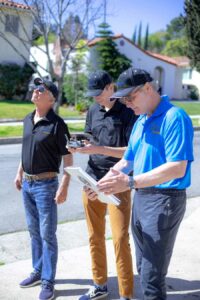
The primary role in every aerial photography mission is owned by the drone pilot-in-charge (PIC), however, the unsung hero of the drone flight crew is the visual observer. Although the drone pilot must always maintain the capability to see the drone in flight, utilizing one or more visual observers allows the pilot to conduct other mission-critical duties while still ensuring situational awareness of the drone.
What, exactly, does the visual observer do? The role of the visual observer is that he or she maintains constant visual contact with the drone, scans for other aircraft and hazards in the area, and communicates to the pilot any instructions required to keep him or her advised on the Drone’s status during flight operations.
Why should any of this matter to real estate agents?
Here are 5 key benefits of having a visual observer on every aerial photo shoot:

Visual Observer Assisting Pilot and Drone Operator
1. Mitigate Risk
Before and during each mission, drone pilots have a tremendous amount on their plate. A visual observer helps to keep the pilot focused on the safe outcome of each mission.
2. Higher Quality Production
An experienced visual observer can also be helpful in setting up important shots by directing the best position and angle for the pilot to photograph the target.
3. Pilot Redundancy
There’s nothing more disappointing than discovering the primary pilot is unable to participate in the mission due to a last-minute emergency. When this happens, a visual observer, who also happens to be Part 107 Certified, can act as a back-up to the primary pilot. Since we feel “the show must go on”, Aerial Decisions always strives to staff each aerial photography mission with this type of redundancy.
4. Scene Management
In the case of smaller productions, the visual observer may also serve as the scene manager, fielding questions from bystanders and dealing with any issues that may negatively impact the pilot’s ability to focus their attention to the safety and control of the aircraft. This is one less thing the real estate agents needs to worry about.
5. Safety
A visual observer keeps the pilot advised on the drone’s location, attitude, altitude, and direction of flight. He or she also notifies the pilot of the position of other aircraft or hazards in the immediate airspace. Finally, the visual observer ensures that the drone does not endanger the life or property of another.
Despite the fact the use of a visual observer is optional when operating under FAA Part 107 rules, they should always be considered an integral part of any aerial photography project.
From The Editor:
Do you need to hire a professional drone service provider? To speak to an aerial data specialist, fill out a form, email us or for even faster response times, give us a call at (833) FLY-4YOU or (833) 359-4968. Check out our transparent pricing at Drone Photography Pricing and watch this space as we expand on the above topics and more over the coming weeks and months. If you like this post, feel free to click the share button at the bottom of the page. We appreciate you helping us by spreading the content we share on our blog.
- Top Drone Software Features for Efficient Construction Projects - June 30, 2024
- How Drones are Changing Building Facade Inspections - June 17, 2024
- Ensuring Success in Construction Progress Monitoring: Insights from a DSP - April 27, 2024
